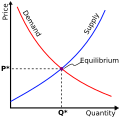
Back Declaración positiva Spanish Beschrijvende uitspraak Dutch Позитивное утверждение Russian Deskriptiv definition Swedish Olgusal önerme Turkish 實證陳述 Chinese
| Part of the behavioral sciences |
| Economics |
|---|
 |
|
|
In the philosophy of economics, economics is often divided into positive (or descriptive) and normative (or prescriptive) economics. Positive economics focuses on the description, quantification and explanation of economic phenomena,[1] while normative economics discusses prescriptions for what actions individuals or societies should or should not take.[2]
The positive-normative distinction is related to the subjective-objective and fact-value distinctions in philosophy.[3] However, the two are not the same. Branches of normative economics such as social choice, game theory, and decision theory typically emphasize the study of prescriptive facts, such as mathematical prescriptions for what constitutes rational or irrational behavior (with irrationality identified by testing beliefs for self-contradiction). Economics also often involves the use of objective normative analyses (such as cost–benefit analyses) that try to identify the best decision to take, given a set of assumptions about value (which may be taken from policymakers or the public).
- ^ Stanley Wong (1987). "positive economics," The New Palgrave: A Dictionary of Economics, v. 3, pp. 920–921
- ^ Paul A. Samuelson and William D. Nordhaus (2004). Economics, 18th ed., pp. 5–6 & [end] Glossary of Terms, "Normative vs. positive economics."
- ^ "Normative Economics". Business Dictionary. Archived from the original on 23 December 2007. Retrieved 9 October 2014.